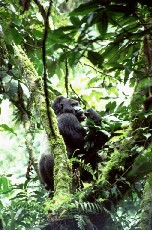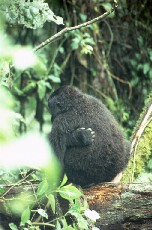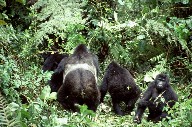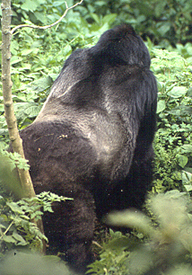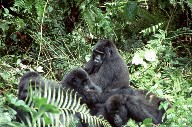“Your office must be the best office in the world.” Paul nodded in agreement as we looked across at the precipitous valley at the south-western corner of Bwindi Impenetrable Forest. The uniform greenness of the forest facing us gave the impression that the forest was a solid wall of vegetation, further enhancing the feeling of impenetrability
Paul Mgisha is a guide for the Uganda Wildlife Authority and I had come to track the Nkuringo gorilla group. No ordinary gorilla group and no run of the mill tracking, I was lucky enough to be part of a project to finalise the habituation of these gorillas before the become open to tourists next year. This in effect meant that I had the unique luxury of having a gorilla group all to myself.
Getting there had been an adventure in itself as the LandRover groaned and strained around the tortuous succession of winding bends. On the western horizon the silvery shadow of the Virunga volcanoes emerged in the dawn light, sat in silent sentinel over our steady progress.
The surrounding scenery was spectacular, a series of round–shouldered buttes, wave after wave of hills and hillocks. Undaunted by such tempestuous seas, every inch of land was under cultivation, vertiginous slopes no deterrent to the determination of the farmers. It was as if a patchwork quilt of browns and differing shades of green had been draped over the land. Every inch that was until we arrived at the edge of the forest, where the cultivated land ended abruptly and the forest began. No gentle merging of the twain but a dramatic break, a sharp contrast between natural forest and farm, indicative of the land pressure in the region and one of the many problems facing both gorillas and farmers.
“We (the Uganda Wildlife Authority) had to buy some of the surrounding land from the villagers,” Paul explained as he briefed me on the Nkuringo group and the rules and regulations of seeing and tracking gorillas. He delivered a comprehensive briefing about various do’s and don’ts to be observed when with the gorillas. I was told not to stand up higher than the gorillas. They don’t like it. I was told not to point at the gorillas. They don’t like that either. Most importantly I was told that if I was unwell I should not visit the gorillas – the danger of contracting human illnesses or diseases is one of the biggest threats to the gorillas. I was also told that I should always try and remain at least five metres away from the great apes, for the gorilla’s safety rather than my own, as the distance would help to reduce the risk of transmission of disease.
The Nkuringo group had lived on the borders of the forest and often made excursions in to farms and surrounding land to eat the bark of eucalyptus trees, very bitter according to Paul, the banana trees and some of the grasses that were presumed to be sweeter than those in the forest. As a result the group had contracted scabies from contact with village dogs. That was some seven years before the habituation process began and before UWA had started buying up the land and compensating the farmers accordingly. As a result the gorilla population was now healthy, scabies an ailment of the past, and its numbers had increased from seventeen to twenty-three. A rare success story for gorillas and UWA alike.
But it was not just the gorillas who seemed to have benefited. The villagers looked relatively well to do, most of the children looked smart in their school uniforms, albeit barefoot, and were very welcoming. No demands from the children of “Give me pen” or “Give me a sweet” (are these stock phrases that they are taught at school?). The definitive benchmark of their prosperity was that each house had a corrugated iron roof.
I had asked Paul why this was, especially given that such roofs were poor radiators of heat – at night and in the wet they let out all the heat and when it is sunny they are unbearably hot inside. Paul told me that there were a number of contributing factors. It was difficult to get the traditional materials, the necessary grasses, and even if they could do so they would have to replaced every year or so, not dissimilar to out own thatched houses. Thatched roofs were more susceptible to fire and some superstitious villagers feared the very real danger of lightning strikes whilst others feared recriminations from disgruntled neighbours. But the main reason was that to have a corrugated iron roof was a status symbol, “the man who has a corrugated roof is seen to be respectable, to be rich.”
“So you have no status given that you live in a tent,” I quipped in reference to the camp in which the guides and trackers of this group base themselves for weeks on end. Paul’s face lit up in a bright smile, “Yes we have no status,” he said laughing.
In fact the opposite is true. Many youngsters want to join the ranks of UWA, whether as guides, rangers or trackers, as UWA provides them with opportunity, the chance of a decent salary, the wherewithal to move beyond the lot of a peasant farmer. It thus bestows the ultimate badge of respectability, more so than a tin roof.
Getting to see the group was not easy. We had to carefully wind our way down steep muddy paths, slipping and sliding, to the bottom of the valley some five hundred metres below us. The stunning views and the glorious forest ahead made up for the hard work and the indignity of ending up on my backside several times. But it was the fact that I was alone with Paul and two trackers that most excited me and made the descent so special. Unencumbered by the huffing and puffing of other tourists, having to make polite conversation, I was privileged to have the undivided attention of Paul and the trackers. And in a short while the gorillas.
After a descent of an hour we arrived at the bottom of the valley floor. A stream gurgled noisily towards nearby Congo and the forest, the domain of the gorilla, lay tantalisingly before us. “The gorillas often come to this side,” Paul stated as he pointed out the depressed foliage, broken plants and the detritus of yesterday afternoon’s feeding. “You can see they went this way afterwards. Look at the way the plants are leaning in the direction they went.” We headed off into the undergrowth, following the gorillas’ trail, my heartbeat racing in anticipation and excitement, trying to find where the gorillas had spent the night.
Each night the gorillas build a nest of leaves and undergrowth in which they bed down for the night. The silverback and the other adult males usually sleep on the perimeter of the group with the females and their young in the middle. First thing in the morning trackers set off to find such a nest and from there begin tracking the group. Thankfully gorillas do not move great distances, moving only about one kilometre each day (they do however move much greater distances if they have been disturbed or distressed). In fact gorillas spend about thirty per cent of their time feeding, forty per cent of the day at rest and the remaining thirty per cent of their time foraging and on the move.
No sooner had we set off down the trail when a call came over the radio that the trackers were with the group and that we should hurry forward as fast as possible. We moved forward and then suddenly we emerged into a slight clearing and there they were directly in front of us. It was a surreal moment and it was difficult to grasp the enormity of it let alone describe my feelings. They were close, no, they were very, very close yet amazingly unperturbed by our presence.
Laid back and unconcerned the group continued to munch on vegetation, stuffing a handful of leaves into their mouths at a time. They calmly and unhurriedly continued to feed and play in front of us. A mother showed tremendous patience with her over-exuberant baby who was tumbling on her stomach. Nkuringo the silverback of this eponymous group sat proudly in their midst, the sheer bulk and size of him dwarfing his brood. He glanced nonchalantly across at us, barely registering our presence and continued to sit serenely.
The calm was broken by a series of bickering barks coming from the trees behind where most of the group was sat. Nkutingo tuned his head to where the noise was coming from and stared intently into the undergrowth. “A squabble,” Paul said. “Perhaps two females fighting over food.” Another bark and Nkuringo moved majestically to his haunches, displaying the full breadth of his broad back and why he, the dominant male, is so named. He moved off to investigate and restore calm. The others followed obediently.
And so, exhilaratingly, did we, the trackers leading the way, vocalising (a deep grunted clearing of the throat) to reassure the gorillas of our presence. Though we did not have to travel far, the terrain that we were moving over was not easy – the name of the park, Bwindi Impenetrable Forest, was not an advertising gimmick to lend a feel of adventure to the experience but a reality. The undergrowth was thick and we were continually climbing under, over, around fallen trees and losing our footing on the slippery slopes.
We crept forward, adrenalin pumping. I froze as a tracker pointed to the tree above me. Nkuringo’s younger counterpart, Safari, the second silverback of the group, was some thirty feet above us. Although gorillas are largely terrestrial, they do climb trees, but it is not common for a silverback to do so – there are few branches that will bear their great weight - and I was fortunate to witness the sight, especially seeing as Safari was so high up.
The younger and smaller gorillas, possibly more confident that the trees would bear their weight, were undoubtedly more adept and comfortable then Safari being up in the canopy. Two juveniles swung playfully in the branches above us, twisting and turning with glee until one would overstretch and come tumbling to the ground. Knocking into a mother and baby, Nkuringo flashed an admonitory stare at the culprit. Duly chastened but undeterred, the juvenile jumped straight back up the tree to carry on where he had left off.
The rest of the growth were more sedate and sat quietly in the surrounding undergrowth. It is difficult to get over how phlegmatic the group were, how untroubled they were by our presence. At one point I found myself to be the focus of attention of one sub adult female. I had been told not to stare at them or to return their gaze but this is easier said than done. Their eyes were unfathomable yet so compelling. Soft and brown they combined elements of enquiry and acceptance. I wondered what was going through her mind? King Kong was not a good public relations agent for gorillas, purely the figment of a writer’s imagination stimulated by early stories that filtered back to Europe of greatly exaggerated descriptions of ferocious man-like beasts that bore little relation to the actual animal.
Eventually Nkuringo exasperated by the antics of two tiresome juveniles decided enough was enough and it was time to move on. Once more he set off. Once more the group followed. Those still feeding in the trees had to cut short their late morning snack. Juveniles scrambled nimbly down; mothers came down more tentatively, mindful of their young babies clinging to them; Safari’ descent could only be described as ungainly and ponderous.
I sat watching the exodus, totally engrossed and absorbed until I was woken from my reverie by a downfall of leaves and twigs. A sub-adult who was high in the tree above me was shaking the tree in frustration that I was blocking his exit. I moved to one side, he slid down the tree in true fireman style, shot me a sideways glance as if to say ‘Why did you hold me up?’ and scurried off to catch up with the rest of the group.
Tantalisingly the rest of the group seemed to be heading towards the stream. Mountain gorillas do not tend to drink much water, getting much of the sustenance that they need from their daily diet of forest vegetation, let alone cross water. It was thus exceptional to see them crossing the stream. Nkuringo and the older adult were confident and assured, stepping easily across a series of rocks; juveniles were more nervous, not having the reach of their elders; the mothers with infants were distinctly wary, careful not to spill their precious cargo, clinging to their backs, into the water.
I would love to say that after such a magical and enthralling hour that I merely floated back up the five hundred metre climb but that would be disingenuous. It was a hard gruelling slog. I eventually made it to the top, drenched in sweat, drained but damn glad that I had done it.
For me seeing the Nkuringo group was a peerless wildlife experience. Yes I was hugely fortunate to see them in the open, to see them so thrillingly all about me in the trees and to see the group crossing the stream. But above all it was the fact that I was alone, not having to jostle for position and compete with budding photographers and all their paraphernalia of lenses, tripods etc. I had the luxury of having them all to myself.
I do not count myself as a greedy or possessive person but this was one experience that I enjoyed having all to myself. It must surely be unique and the ultimate wildlife experience – where else in the world can you be virtually guaranteed of seeing one of the most endangered animals in the planet and do so all alone. I would have it no other way. Except possibly to repeat the experience with my daughter when she is old enough. With a success story such as Nkuringo that is thankfully quite possible.
|
|
|
|
